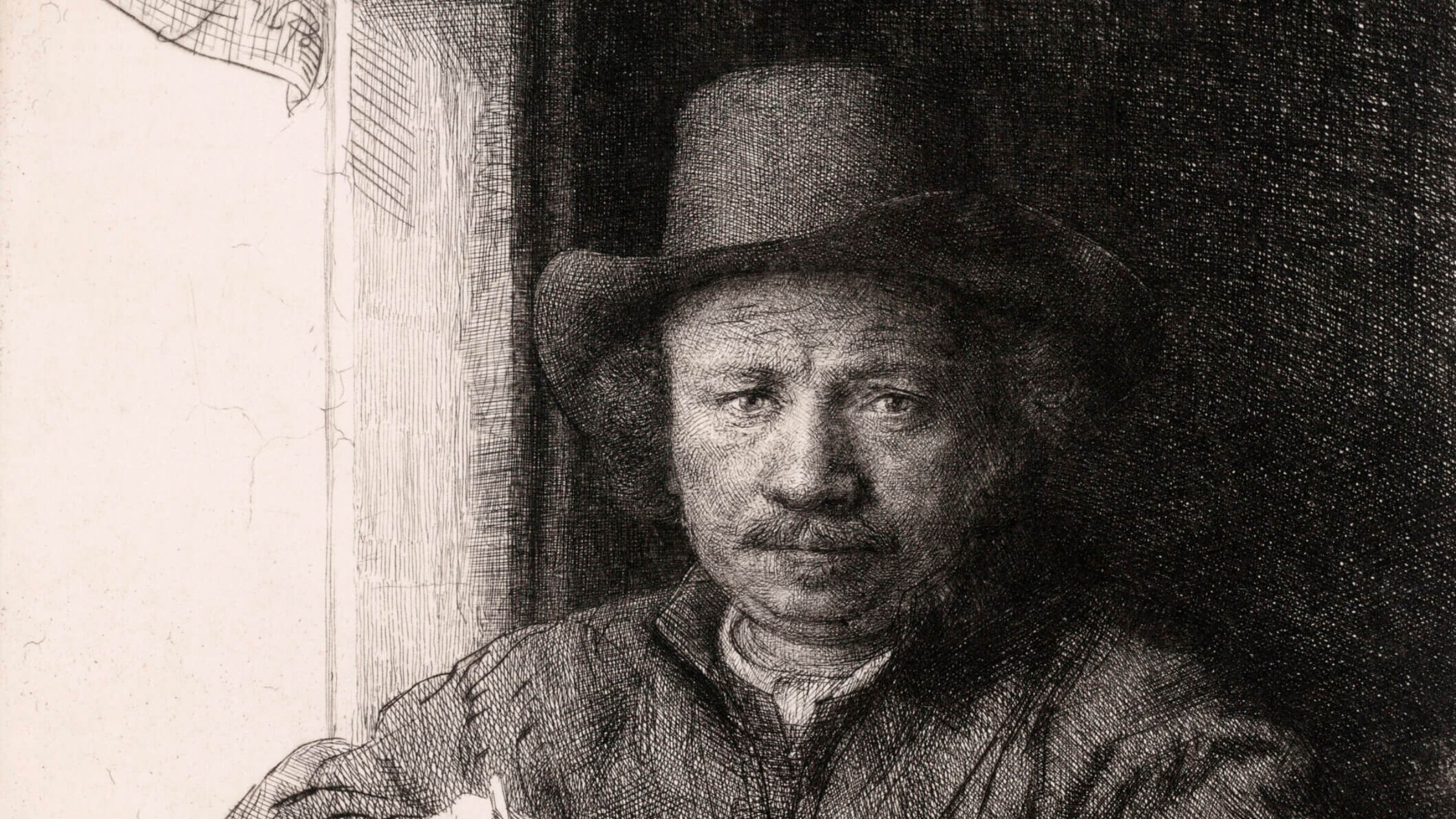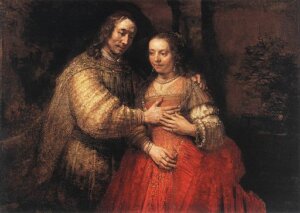Can Jews still embrace Rembrandt — even if his love for the Jewish people is only a myth?
As a new volume attests, the Dutch painter’s philosemitic reputation may have been greatly exaggerated

A self-portrait bv Rembrandt van Rijn, 1648. Photo by Getty Images
A new book about the relationship between the Dutch painter Rembrandt van Rijn and the Jews points to the peril for Jewish art lovers of wishful thinking.
Rembrandt Seen Through Jewish Eyes: The Artist’s Meaning to Jews from His Time to Ours edited by Mirjam Knotter and Gary Schwartz, marshals all the historical evidence to assert that most of what has been seen as an extraordinary sympathy between Rembrandt and the Jews is mere myth.
Among the most far-fetched of these tales, based on no evidence, was that Rembrandt even converted to Judaism after a Calvinist upbringing.
Through centuries of murderous hostility against Jews, it is natural that Jewish observers should cling to images by the artist supposedly depicting Jewish models, almost all men, whom he reportedly recruited when living in an artist’s quarter of Amsterdam that also happened to be the neighborhood that sheltered Sephardic Jewish emigrants.
Rembrandt’s ability to recreate humanity on canvas resulted in three-dimensional human beings. No Jewish art lover can experience solitude in a museum gallery where a Rembrandt portrait is present, whether or not a Jewish sitter was actually involved. For a Rembrandt portrait reincarnated an entire person, indeed a mensch, and all the related life experience involved.
From this, it was easy to stretch to the emotional declaration by poet Hayim Nahman Bialik in a preface to the 1932 Hebrew edition of the Russian Jewish painter Leonid Pasternak’s study of Rembrandt.
Bialik opined that although Rembrandt wasn’t Jewish, he must be considered an “honorary Jew for his love and empathy towards the Jews.”
“Rembrandt — a genius among artists, a non-Jew — miraculously managed to perceive the true Jewish spirit, penetrating its depths as no Jewish artist had,” Bialik wrote.

And yet, as researchers looked more closely at the documented facts surrounding Rembrandt’s life and work, much of what had been traditionally accepted proved unreliable. So a portrait of Rembrandt long identified as representing the Portuguese rabbi and kabbalist Menasseh ben Israel, founder of the first Hebrew printing press in Amsterdam, turned out not to be the rabbi at all.
The supposed Menasseh ben Israel portrait didn’t look like him, and even failed to contain any clues that the sitter might be Jewish or a rabbi. Relatively few artworks by Rembrandt may be plausibly said to have Jewish sitters, compared to the inflated number of images to which Jewish connections have been ascribed.
Solider evidence exists for Rembrandt’s portraits of Ephraim Bueno, a Jewish physician, whom the artist immortalized in a small oil sketch, intended as a preparatory study for an etching. Some have diagnosed Bueno’s facial expression and outward glance directly at the artist as arguing some kind of personal relationship. But the German-Jewish iconographer Erwin Panofsky felt that despite Bueno’s soulful expression, his face did “not really correspond and is, above all, without the accentuation of Jewish racial characteristics.”
Among leading debunkers of the many fables surrounding Rembrandt and the Jews, Steven Nadler, an authority on the Dutch Jewish philosopher Baruch Spinoza, further overthrows the notion, advanced by earlier generations of art historians, that somehow Rembrandt and Spinoza were pals.
Nadler concluded that in Rembrandt’s day, Spinoza was a “nobody, and certainly not yet the great philosopher he would later become.” No one would have been urgently motivated to introduce this unpromising young man to the already-famous painter.
Nor was Rembrandt’s interest in biblical themes or picturesque Jewish characters unusual among artists in his circle, none of whom were ever honored by posterity for being especially fond of Jews.

Rembrandt was not even exclusively attracted to Jews as a minority group. He also depicted members of a small community of Africans in his Amsterdam neighborhood, and these sensitive images are no less empathetic and humane than his images of Jewry.
In the new book, Shelley Perlove points out that Rembrandt’s persistent interest in Jews and Judaism was always within a Christian context. He was intrigued by Jews in his neighborhood, escapees from the Inquisition in Portugal and East European pogroms, in terms of visualizing Hebrews of biblical history.
Like any painter seeking visual cues, Rembrandt achieved what Perlove calls a “semblance of authenticity,” even if those seeking literal accuracy in liturgical practice or traditional garb will inevitably be disappointed.
Rather than an atypical pro-Jewish advocate, Rembrandt instead fully accepted the general Christian belief of his era, that Christianity redeemed Judaism, an inferior and superseded belief.
Intrigued by Jews as an exotic element more than as unabashedly admiring them, Rembrandt used visual references to heighten the authentic look of his compositions. Rembrandt was “no Hebraist and had no direct knowledge of Jewish sources,” as Perlove notes with implicit irony about his using Jewish models to bolster a Christian message.
A 17th century Dutch poem about a painting of Jesus by a Rembrandt pupil accentuates bitterly how the depiction presumably involved a Jewish sitter, a non-believer in Christianity:
“For this Christ would not speak of Christ except in blasphemy./ The heart is not reflected by the face that shines on you./ You ask how come? Because the model was a Jew.”
Nevertheless, in a time when even mildly benevolent interest from Christians was rare, Rembrandt made a lasting, powerful impression on generations of Jewish observers. The influential German Jewish biographer Jakob Rosenberg, in 1948 proclaimed as “indisputable fact” that Rembrandt’s attitude toward the Jewish people was “an unusually sympathetic one.”
More recently, Gary Schwartz, co-editor of the Amsterdam Press volume, has reminded us that Rembrandt adhered to Dutch Calvinist beliefs which, following medieval lore, rejected Jews as stubborn non-followers of Jesus.
Nor did Rembrandt’s attitude toward the Jewish people differ from those of his contemporaries in the art world of Amsterdam. Schwartz has been arguing for four decades that descriptions of a philosemitic Rembrandt were uninformed “sentimental conjecture.” He suggests that after an objective examination of the evidence, “quite a different, less heart-warming picture emerges of Rembrandt’s attitude toward the Jews.”
The challenge for Jewish admirers of Rembrandt is whether they can still revere an artist who was profoundly and traditionally Christian in doctrine, despite long years of misleading interpretations.
Would Rembrandt have kvelled over latter-day lore about his supposed closeness to Jews? Gary Schwartz points to Rembrandt’s “Self-portrait as the Apostle Paul,” now in the Amsterdam Rijksmuseum, created in the spirit of St. Paul’s “First Epistle to the Corinthians.”
In that document, the Jewish-born leader known to many as Saul even after his conversion, supposedly declared: “To the Jews I became like a Jew, to win the Jews.”
So Rembrandt’s motivation was likeliest, according to recent studies, the Calvinist goal of converting the Jews and all other non-Christians, including Africans. As such, Jewish admirers of Rembrandt may henceforth need to seek less Yiddishkeit in their hero, while still appreciating his abundant importance and achievement.
























